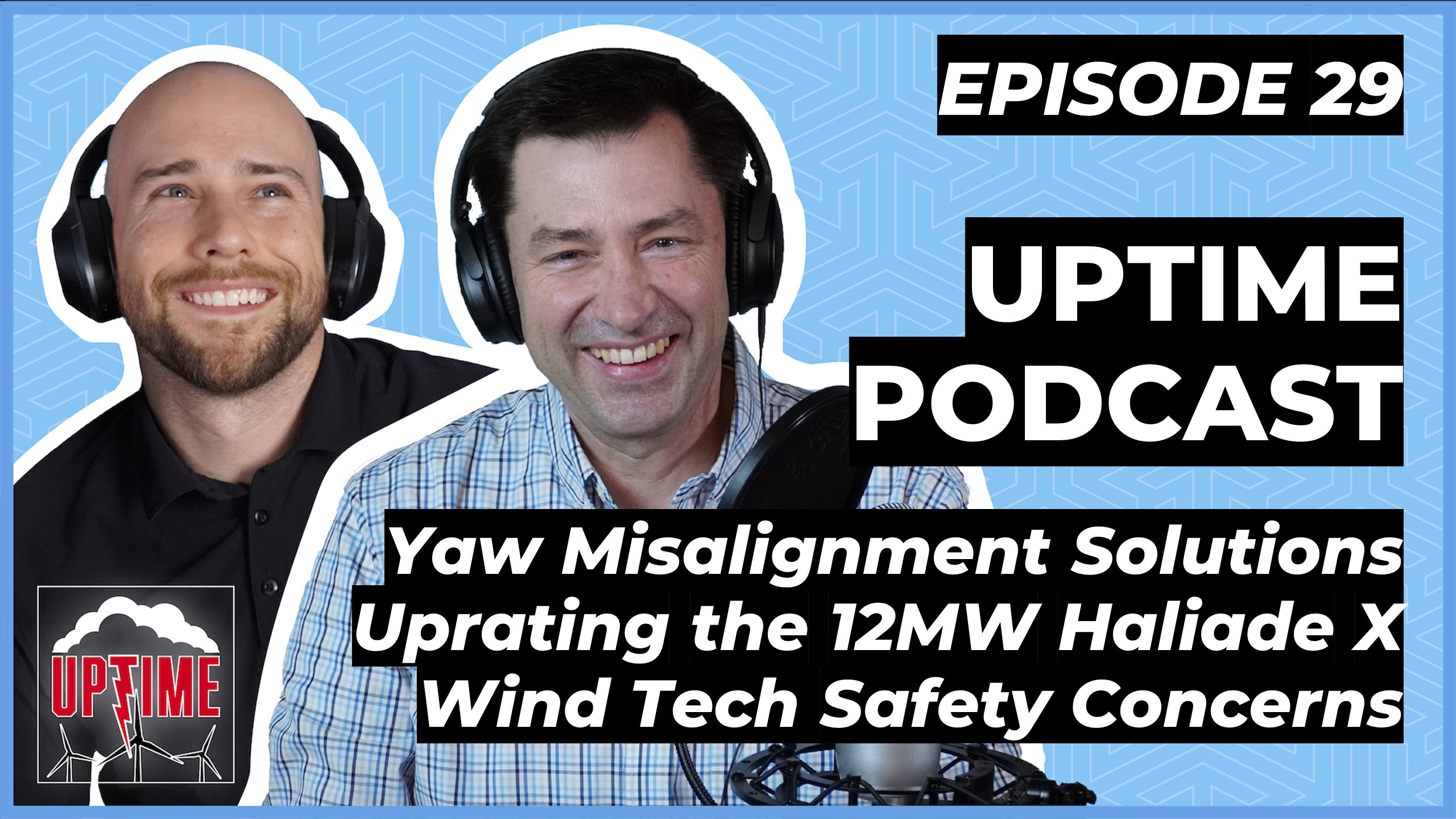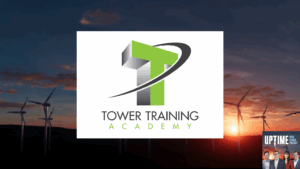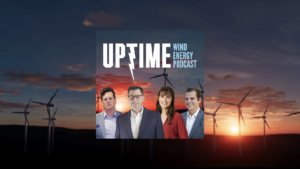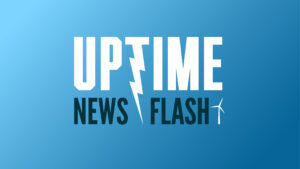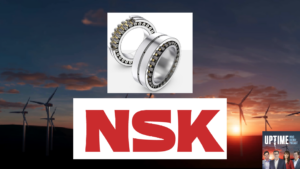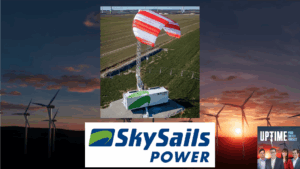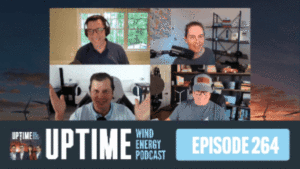In this episode we discussed wind turbine yaw misalignment and its common causes and solutions. We also talked through a recent turbine technician death, and what this tragedy means for the wind industry. Lastly, how easily can wind turbines be uprated to an increased power output? We dove into the GE Haliade X turbine’s 13MW version, which is uprated from the original 12MW design.
Learn more about Weather Guard Lightning Tech’s StrikeTape Wind Turbine LPS retrofit. Follow the show on YouTube, Twitter, Linkedin and visit Weather Guard on the web. Have a question we can answer on the show? Email us!
Podcast: Play in new window | Download
Full Transcript EP29 – Technician Safety, Uprating a Turbine? Plus Wind Turbine Yaw Misalignment Causes
Welcome back i’m Allen hall. I’m Dan Blewett and this is the uptime podcast where we talk about wind energy engineering lightning protection and ways to keep your wind turbines running
Alright welcome back to the uptime podcast in today’s episode the big two nine we’re to cover a bunch of different topics number one unfortunately there was a death of a technician falling from a turbine so we’ll chat a little bit about the implications for the industry there was also another broken blade on a wind farm out in illinois and uh we’re also going to chat a little bit about some i guess there’s been some a decrease in lightning recorded in the lower 48 states here in the U.S. So Allen’s gonna talk about why that might be happening and some of the implications there but obviously in our first segment here you know there’s uh some of the the pushback against wind energy is stuff like this you know safety worker safety uh broken wind farm blades and the safety concerns that they they hold so that’s you know as much as wind energy is an important uh green seemingly good for the environment good for everyone there’s always some downsides that uh you know pr and we have to kind of cover so in our engineering segment we’re going to talk with the halle 8x turbine being upgraded from 12 to 13 megawatts and we’ll chat a bunch about yaw misalignment and the power reduction that that causes and how we can kind of uh solve that issue so now let’s talk first about the the worker death so unfortunately a 39 year old man fell to his death at the langford wind project in texas um cotton just awful thing but i mean what are the implications here for the for the industry it means this is going to have more regulations coming i mean is this an osha thing or definitely osha definitely oh she’ll be on top of it and local regulators will be all over it and trying to figure out exactly what happened and usually when you’re going up on a on a turbine you’re not by yourself uh so there’s probably some witnesses to what happened i i’d be surprised uh with as much safety equipment and and gear that are provided to the technicians that it was a gear problem but maybe it was um but there seems to be if you if you’re around the wind turbine industry much at all you realize that there’s paramount emphasis put on safety gear falling safety protocols check double check you’re working around electricity and you’re working at high out height places and it it is you so you got the steel toe twos you got the harnessing you’re clipping in everywhere uh you’ve got the hard hat on safety glasses no joke it’s a serious place and you’re doing serious work so i’m shocked at what has happened here particularly up tower but hopefully everybody doubles down and takes a quick pause and a lot of places we’ll take a safety pause and just refresh everybody hey let’s make sure we’re clipping in hey let’s make sure we’re in the harness hey let’s make sure we’ve checked out our safety gear before we start climbing uh as just another added measure so hopefully it it’s used for the benefit of the industry right that this unfortunate loss can be can be have some upside to it yeah i’m sure with anything as you get you know more and more experience you just you’re you know you go through your checks and all that stuff but it’s can sometimes become a routine and when things start to feel routine sometimes things get get missed and again we don’t know what happened here but you’re right hopefully just rein reinstalls that sense of urgency and extra checks and and a really big focus on safety because that’s yeah that’s real really rough so in mclean county illinois where i actually lived for quite a long time um a another turbine blade snapped and pretty incredible photo that same thing like pretty pretty close to the root it looks like there’s maybe 20 feet left on the one blade and uh you know it’s there’s a lot of them out there in mclean county there’s a really really big wind farm out there um so again same thing here when there’s blade snapping especially in a a few at this in a relatively short span of time because we talked about one in ohio recently i mean is this bringing a lot of bad pr to the industry because these are kind of the big things like are these things safe these huge blades hurtling around at 180 miles per hour they snap off to somebody get hurt um what are your thoughts here i think what we have to relook and see what’s going on with with the turbine blades right we shouldn’t have turbine blades breaking obviously anybody who designs them and manufactures them thinking the same thing what’s going on are we what are we missing what is happening either in the design is there some design issue which is where you usually start at is it a design issue make sure we haven’t forgotten something or or miscalculated a load or is it somewhere in that in the manufacturing that we’ve uh forgotten to do something or over you know there’s a there’s a million different things we’ve gone to composites which would uh degrade the composite where he could have issues like this and then the quality system right so you get you have a checks and balances set up where a worker does a certain feature somebody else checks it off and there’s other inspections that are done to make sure that the quality blade is what you think that it is and it matches the design and yet when we’re out in the field all of a sudden we’re having these sort of blade breakages and it could be like we talked about uh last week on with dnvgl that you just have a severe wind event that causes it to overload and it’s not designed for those when when speed’s fine but it does just the i was watching some interactions at a basically it was a county meeting in iowa talking about wind turbines they had a blade break and they’re putting restrictions on turbines they’re limiting the number of turbines they could have in the county they were discussing how far how far apart they had to be had to be so when a blade breaks it provides the impetus and and i guess rightly so that the the community is going to then put restrictions on them so if that blade didn’t break there’d be less restrictions and probably more wind turbines but uh when you have a blade break it really changes the dynamic to all right not only are the the turbines making wind noise flickering light got it but now it’s gone from sort of a nuisance question to and people don’t think it’s a nuisance people take that seriously i’m not saying it’s not serious but it’s not as serious as a blade breaking off and hurting somebody so when it gets to that level you know the the gloves get taken off and then you got into a real fight and the and the operators and and owners of those of those sites have a lot to deal with and it becomes a sort of this public relations thing yeah well and to be clear in this situation yeah this was the most recent was actually the third blade in this farm so the 57 turbine farm uh the bright stock wind farm and so there were two two failures on september 7th this is now the third so that’s definitely becoming a pattern right they think there might have been lightning damage but three blades these are all manufactured by vestus so they’re trying to get to the bottom of it and you wonder if there’s some sort of quality control issue maybe maybe and maybe some lightning issue maybe it’s something that we haven’t thought of but we’re going to get a lot of people looking at it and that just takes up an insurmountable amount of time to to do those uh post-mortems on damaged blades we’ll hopefully get to the end of it and we’ve talked about lightning strike damage but it’s not clear i mean what’s the mechanism between a lightning strike snapping a blade i mean it’s just putting a big enough puncture in a really important unfortunate unlucky spot and then just the stresses of the blade and the incredible speeds what snaps it apart that’s pretty much it yeah you get a if you think of it in terms of metal composites work differently a little bit but it’s easier to think about taking a piece of metal and flexing it flexing and flex and you get these fatigue cracks right you eventually you gotcha you wear it out it doesn’t happen exactly that way in composites but if you damage it and change the way that it carries the load you can get these weak points and it’ll eventually break like anything else would break uh and that’s the hard thing to think about is is it something and when you have three like this or more than one let’s just start off if it’s more than one you start to think manufacturing defect that they probably manufactured roughly the same time came out of the same manufacturing site and there’s a lot of manufacturing sites it was just an oversight or a materials thing or a cure temperature or a myriad of other things and so what happens is they start grabbing engineers and say go back through figure out what happened and come back to the report which is what they do and then you try to figure out if it’s uh what the root cause is and trying to fix it because the as an engineer your worst thought is oh man i hope this does not extend beyond the blades that we’ve already had this issue with or do i have to go out and inspect a bunch of the blades because we’ve notified we’ve identified a particular variable that we haven’t controlled as well as we thought we had about a piece of instrumentation and that carried on to to multiple blades and multiple sites and like we’re getting on an airplane to go check all these things out that’s your worst case scenario for engineer your best case scenario is it’s a one-off just a fluke the random fluke wins too strong broke it okay we can deal with that it’s the oops i made a mistake in the manufacturing area that really gets you
so decrease in lightning in the lower 48 states the national lightning detection network found a 32 decrease in lightning accounts in may and june of 2020 so why would this be alan what’s going on with with the us right now okay so does this tie into my to my uh paper from india saying during covet there was less lightning strikes also it’s about the same time frame what year what was it 2020 spring of 2020 this was 2020. yeah i don’t remember the india one but yeah it sounds right yeah that was that was that was 2020 also so there’s a big discussion going on about pollutants in the air and changing lightning strike frequency because when you break down air if you change basically change the the breakdown the amount of voltage it takes to break down the air and ionize the air if you change that by adding particles to it which is what pollution in theory is you can actually change the breakdown voltage and are you changing the breakdown voltage you’re getting more repeated strikes because it’s just easier to do and so now there’s multiple papers they’re saying the same thing as when the economy is essentially shut down and you’re not driving as much cars not being driven as much you’re not burning as much fossil fuels you’re not doing a bunch of other things not flying as much you name it uh now maybe we changed the essentially the air resistance and if we are that’s a fascinating discovery because this is i’ve been trying to make this point for a long time like things are changing but we’re not necessarily it’s it may be climate change and maybe other a myriad of factors we just don’t know but when we have these odd events happen like covet or 911 even when when the united states shut down air travel for a while and there was no contrails in the sky they saw temperature changes right and so you’re like man you can actually measure some of these things when society has wide shifts and sometimes it’s the best time to to test theories is that if if we’re decreasing the amount of of uh particles or shoving into the air does that change the amount of lightning strikes yeah i think the answer is yes but it’s actually decreasing them making the air more resistive in some sense and that is fascinating so we are having an influence on the number of lightning strikes that’s what it looks like but i’m not sure the answer is not why they’re just noticing there’s a cor correlation is not causation is that what my daughter always tells me right isn’t that the phrase got around correlation not causation so we have a correlation but we don’t have a causation yet so we need to get to the causation part because i’m interested in that because i think it also changes the way lightning strikes happen on other things like aircraft that would explain uh things that i think are changing a little bit than what we have previously done so this is the our conversation with uh the wonderful people at dmvgl which is uh how are we predicting how many lightning strikes are going to occur and as our models need to be constantly updated because of changes that are happening in the atmosphere and are we using data from the 1920s and 30s to predict what happens in 2020 yes we are but is that data’s still valid because our the the uh sort of the resistance of the air which does matter was different in the 20s and 30s than it is now because society’s changed and we the things are putting in the air are different so maybe we’re seeing a different response that would be fascinating to know really interesting yeah so you might need a you know if you have a wind farm in los angeles you know obviously you wouldn’t have a wind farm in los angeles but if you did the lightning environment would be a lot different because it’s just how smoggy it is potentially yes it’s like somewhere like montana where do they even have cars in montana they just run around in oxen and whatnot i’ve been to montana there are cars there yes there are people there’s a lovely place very blue sky beautiful place much better much better oh yeah it’s beautiful montana is beautiful but i i this this is my question about some of the the fires that happened in the northern california and that oh we had this we had a huge number of lightning strikes well which came first i mean obviously there were storms which are unusual but did one does does the previous fire encourage more lightning strikes this is the soot and the crud that gets thrown up in the in the ash to get stoned up in the air and that can go thousands of feet up into the air is that changing subsequent lightning strikes we’re getting more subsequent lightning strikes because of the fires that already exist i i think the answer is yes and in northern california there’s a lot of wind turbines uh just to the east of silicon valley and san francisco so if you know your northern california
layout right so everything’s kind of pushed to the coast but as you get further east that’s where the wine country is it’s now on fire but there’s a lot of wind turbines up in that area and i kind of wonder if they’re seeing more strikes up there because of the fires and this and the contamination in the air and hopefully somebody’s doing a research paper on it and going to publish that because that would be really interesting to know as we go forward making requirements and specs and things but the number of strikes that we’re taking on wind turbines is it changing over time and do we need to address it in the way we’re designing the wind turbines today i think the answer is yes but we still need more data and uh more study to figure that out
all right in our engineering segment today we are going to chat first about the GE Haliade-X which is the second most powerful wind turbine in the world next to the poorly named Siemens Gamesa 14 222-DD right so we like the we like the Haliade-x here a lot uh on on uptime it’s a great it’s a great it’s a cool name it’s cool name but they took the prototype which was 12 megawatts and they’re developing it into a 13 megawatt variant to try to catch up because they’re sad um you know not quite 14 but you know they’ve had a pretty big order of these uh the dogger bank wind farm is going to feature 95 of these so crazy amount of power output but the question here is how do they operate a wind turbine because they it sounds like they’re not changing the rotor diameter or the blade length of the same blades on the 13 megawatt as the 12 megawatt so alan is it vortex generators is it you know trailing edge serrations is it something else is it a generator thing how are they getting how are they squeezing another megawatt out of it well i think it’s mostly a generator uh issue that they’ve upgraded the generator so it would be very similar to um on a car if you bought a production vehicle from general motors uh say you had a corvette right and that that that motor is set to produce let’s just say it’s 500 horsepower can you get 510 horsepower out of it yeah you you probably can it was with the right tuning and the right um uh probably add-on pieces you can actually get more horsepower out of that motor people do that all the time and on generators it’s sort of a similar thing if you can design it to with or or test it at a higher level than what it was previously tested for and show that it can withstand the years of abuse it’s going to take you can actually increase its rated output which is tends to be what happens think of an engineer sitting at their desk designing a generator what’s the first thing that goes through your head don’t let it explode don’t let it fail so everything you do to that generator is like is is not over designed on on purpose but it is over designed on purpose because that’s that’s the engineer and everybody is to provide a little more margin because you don’t want your stuff to break yeah and then when you get it out there in the field like can you flip it on like wow it’s working pretty well it seems to be pretty stable it doesn’t seem to have a lot of temperature variation seems to be producing the power no sweat well let’s see what it can really do right and that’s what that’s what’s happening you’re seeing how much that generator can take and if it can and they qualify it for a higher rated output you can just use it because essentially what you’re doing is you’re taking that little extra safety margin that the engineer has thrown into the design and you’re taking advantage of it to produce more power that’s that that’s essentially what happens there uh the engineers if you ever have a conversation with an engineer because it happens on on jet engines all the time uh where the the jet engine is rated for say it’s a thousand pounds of thrust and every aircraft designer knows that you’re never gonna make weight on an airplane you gotta eat more thrust and sure enough you know they can turn up the thrust by ten percent how did that happen because it had the ability to do it when they made it it’s just going to cause a little more wear and tear it’s going to decrease the lifetime slightly but you may not even care and i think what’s happening here is a very similar thing is that they’re basically using the same basic wind turbine the cell is the same sounds like the the blade diameters are the same they just upgraded the or rated the generator for a higher output which is a smart thing to do because you’re in this competition ge is in this competition with siemens gameza for these huge wind turbines and we talked about before setting the marketplace is a big deal uh and that’s why the naming convention matters is the halleat versus the whatever dd sg14 doesn’t matter yeah going from the uh the the halle a12 megawatt to the heliod 13 versus the siemens camasa 14 megawatt it’s all about market positioning and owning that space and as wind turbines get larger and larger you want to be the first one in that market you want to set the criteria for everybody else you want everybody to be looking up to you all the time so that’s why there’s this race to get to the large wind turbines offshore because that’s where the future is in wind turbines that’s where the money is in wind turbines is these large offshore wind turbines so it’s it’s going to be a battle over the next year or two as GE and Siemens Gamesa duke it out yeah so speaking of squeezing out power output from these wind turbines uh yaw misalignment is potentially a pretty big problem so alan can you take us through what yaw misalignment is why it’s important and i mean this could be a really big power loss if it’s not caught and kept in check oh yeah yes so you want the wind turbine ideally be pointing directly into the wind right but you really only have one measurement for that which is the wind vane and make sure that wind vane is uh quasi-aligned with the hub sort of speak like your your readings are correct um so there’s a couple ways you can you can mess that up so if the wind vane has been bent over like you had an eagle land on it and can’t get over it or it’s been hit by a technician bumped by technician or rotate it slightly now you got a kind of a cross thing going on where the direction of the wind turbine is in the wind vane zero spot is not aligned so the wind turbine will be slightly askew all the time that’s a bad thing because you’re not maximizing power output so you want to make sure you’re constantly pointing in the right direction and the the issue gets to be is you can’t really tell it all that well because you don’t have a you don’t have a an independent unless you have a met tower you really don’t know what direction the wind is coming in all you’re reading is what’s going on on your anemometer which is wind speed and you win vain which are all mounted behind the blades by the way so if you watch um wind turbines in the in the wind vanes the wind mains are constantly bumping left to right because there’s a blade running in front of them so the blade blocks the wind and the pushes the wind one way or the other so the anemometers are constantly kind of bouncing left or right and so what it’s trying to do is average out to zero like you’re always uh pointing in the wind source always to the left and also the right the same amount of time roughly and then boom you’re there and if you’re not quite there or you got some weird thing happening with the atom with the wind vein or anemometer for that matter that you can not be at peak power and operators hate that because you’re just losing money you need to be a peak power all the time so uh i know it sounds simplistic but wind turbines are not complicated animals on the way their control systems work there isn’t like there’s a lot of redundancy there and i think the way that they’re detecting issues is because they have say there’s 50 wind turbines on a farm if 49 of them are all pointed in this general direction and wind number turbine number 50 is pointed five degrees off the other way you go huh weird huh and i think that’s how they’re trying to track it is just by quantity not by individual turbines and noticing what’s wrong with particular turbine but it is one of those things to check it’s just like everything else in a wind turbine anytime you’re trying to squeeze efficiency out squeeze power out of a generating piece of equipment everything matters and so pointing this thing into the wind is huge and making sure that we’re properly aligned all the time so besides hardware causes there could be some some software causes that right so potentially the nasal transfer function or just the the parameter set you know in the yeah there could be an offset yeah you can put offsets in like any it’s always it’s always the first fix change the software right so there’s always little variables you can adjust to kind of tweak a system in much like an engine a a gasoline-powered engine you can change the parameters add a little bit of compensation take a little bit of compensation out uh change the control loops a little bit to track it better because you think about it you know what there’s a lot going on on a wind turbine you don’t want the wind treatment constantly searching left and right for the wind right you want it to be stable and just pointed generally in the right wind direction all the time so there’s a little bit of a feedback loop on not making the turbine bounce around all the time and also you don’t want to be constantly spinning in the same direction so if it’s if it’s constantly moving counterclockwise it’ll you don’t want that because there’s cables inside of it which will break so you want to track the more times it’s circled around and then unwind it but so all these systems unlike a car or a train or an airplane which tend to have dual redundant triple redundant systems wind turbines don’t tend to be that way they tend to rely on the number of wind turbines just try to provide that feedback loop that outside feedback to see if things are off so it just seems like it’s easier then for it to be off and no one necessarily catch it there’s no redundancy to immediately fix it yeah i think it’s up to the technicians to monitor that uh that aspect of it and also the the people that are monitoring the power output uh because you know the the the power the power output is is provided via data link to laptops across the country or the world so they’re costly monitoring the power output and in theory you think you’d be able to detect uh where one wind turbine is slightly offered another but as as pointed out by dmv gl and alex last week was unless you have an independent measurement of wind you really don’t know so it’s it takes more deduction you have to be a kind of a sleuth out there to figure out where you’re losing power where you’re losing money and that’s where where comes the detective part comes in all right we’re going to wrap up today’s episode of uptime if you’re new to the show welcome if you’re a regular here thank you for your continued support please subscribe to the show and leave a review on itunes spotify or wherever you listen to podcasts don’t forget to check out the Weather Guard Lightning Tech youtube channel for video episodes full interviews and short clips from each show for alan and all of us at Weather Guard stay safe and we’ll see you next week
is downtime causing you financial pain and putting a stop to your power production for months on end it’s no secret lightning strike damage is a major cause of wind turbine downtime this damage is preventable with our easy to install strike tape lightning protection system for wind turbine blades our incredible engineering build quality materials and edge sealants withstand up to five times more abuse in the toughest weather and lightning conditions and we’ve got the research to prove it if you’re tired of constant downtime we can help reach out to us at weatherguardwind.com and schedule a free call we’ll get your uptime back in no time.



